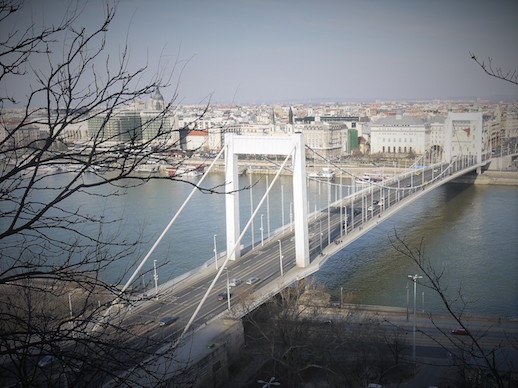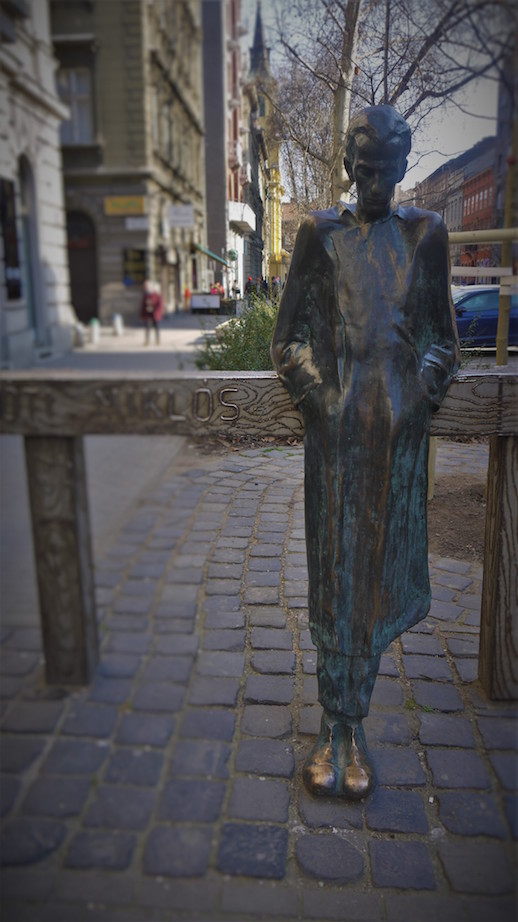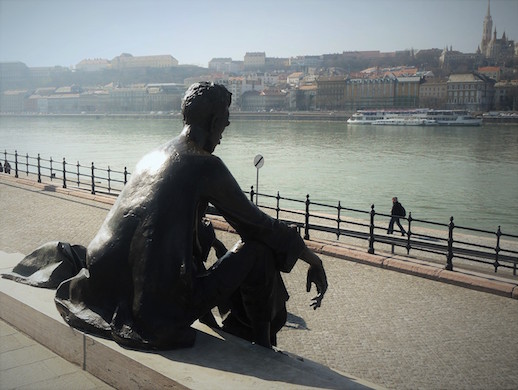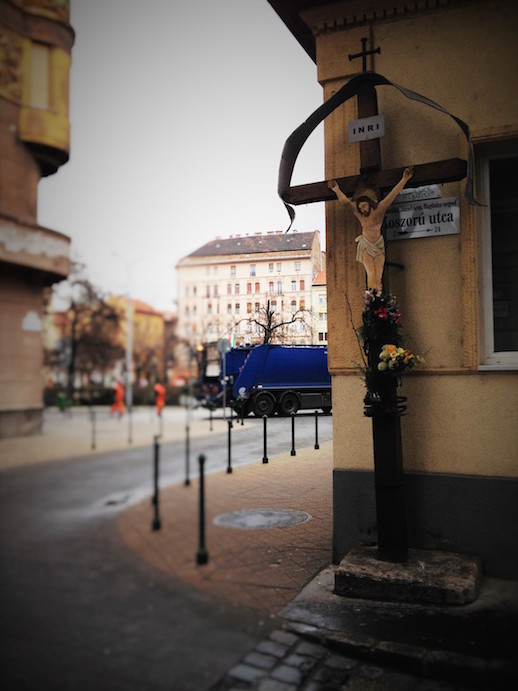Words and pictures: Nick Bellorini
The best meal of the week is at a modern kosher place in Erzsebetvaros, the old Jewish district of Pest, and site of the ghetto in the last months of the war. The restaurant is just past the Orthodox Synagogue, where the ironwork pattern on the doors is alarmingly reminiscent of swastikas: prompting us to wonder at an act of sublime cultural re-appropriation; or, surely more likely, just a bizarre aesthetic coincidence. The restaurant is called Kőleves or ‘stone soup’. It’s a wonderful, informal place, with young staff and a mixed crowd, its informality belying the quality of the fare. There’s a courtyard garden (or kert) there too, open for the long, hot months of the Budapest summer.
The story of ‘stone soup’ is well known in various forms (sometimes it is nails, sometimes buttons) across continental Europe. It speaks of the virtues of guile in a good cause, that of the promise of cooperation and acceptance. It tells of a hungry traveller spurned by unwelcoming villagers who are nevertheless intrigued by the spectacle of him making the stone soup – just a stone boiled in a pot of water. ‘Oh yes, a famous delicacy where I come from. Unsurpassed for flavour, though some do say it can be improved with a few potatoes.’ Drawn in by their curiosity, the villagers soon part with herbs, vegetables, even a little meat, and the wily stranger ends up with a feast which, in the most convivial renderings, everyone gets to sample.
The food at Kőleves is so good we eat there twice. The most memorable dish is a delicately flavoured but unctuous boil of broccoli, paprika-devilled quail’s egg and wild garlic, the latter making a happy appearance on the menu as ‘ramsons’.
Pest, the city on the eastern bank of the Danube, is an architectural broth of Habsburg-era palaces and institutions, Belle Epoque apartment blocks and arcades, mixed in with some early modernist town planning and vestigial slums. Its history, endlessly reconstructed like its stone skin, is proclaimed in street names, squares, plaques and monuments: tribal creation story through serial occupation, war and liberation. From Arpad to Puskas (a giant mural in Erzsebetvaros commemorates Hungary’s 6–3 demolition of England at Wembley in 1953) we see the ebb and flow of the fortunes of the plucky magyarok, from Christian bulwark to anti-Soviet freedom fighters. Not that the city cloaks its place in Europe’s nadir. One of many memorials to those dark days, a plaque on Wesselenyi utca invites all who pass to stop and recite the 23rd Psalm, offered in Hungarian, English and Hebrew, to honour the dead of the Shoah.
We spend much of our time wandering these streets, and those of the neighbouring districts of Terezvaros and Josefvaros. These central districts bear the names of Habsburg royalty – Elizabeth, Theresa, Joseph, Franz and Leopold – a curious nod to a dynasty which, for the all the prestige it brought to an imperial co-capital, effectively bound Hungary to the repeat horrors of defeat in two world wars. They offer a mix of grandeur and more intimate (often dilapidated) human detail. The inner courtyards of Pest are famed. Some have been transformed by investment, others reclaimed as public spaces (such as the famous ruin pubs), where yet others retain a degree of continuity of habitation, individual or institutional. Many poignant details are only glimpsed once behind newly-rendered facades. One courtyard reveals two sets of bullet holes: those to the right are Nazi, those to the left Soviet.
Just about every street and public space in Pest is named after someone, reflecting some human story woven into an accepted history of the district, city, or the nation. Indeed the history of this city would perhaps be best told as a history of street names and, especially of course, the changes in street names. This shifting of who’s in and who’s out, though hardly unique to Budapest, nevertheless speaks volumes for the instability of the stories Hungarians and the Budapesti wish to tell about themselves, their recent history and their future.
And so there was once a Mussolini ter (square) and even a Hitler Adolf ter. The city’s most famed street, Andrassy ut, has had many identities – ‘Stalin Street’ after the war, then in 1956 with fleeting poignancy ‘Avenue of Hungarian Youth’, it then lapsed into the grimly utile ‘People’s Republic Street’ during the Kadar era, before returning to the original in 1990. Republic Square has recently been renamed ‘John Paul II Square’, as the current regime seeks to emphasise its good Christian credentials. Roosevelt has recently lost his square to St Stephen – as if the latter were not nearly recognised enough in the city’s nomenclature. Surprisingly Moscow Square, across the river, somehow managed to make it through until 2011, and is now Szell Kalman ter (though they still haven’t taken the old signs down).
With a crowning absence of subtlety, the sign for Karolyi utca in the central Belvaros district actually sits beneath the sign for its predecessor, Karolyi Mihaly utca, the latter with a diagonal red line through it. Karolyi was the country’s first democratic leader, briefly, after the Great War. He later became a socialist. The reversion is to the great noble family of the Habsburg era, of which Mihaly was but one, presumably aberrant, member.
Predictably there is not much more stability to be found in the stories told by that other stone record, the city’s statuary. Karolyi M. has gone (again). Ronald Reagan is in. Even Horthy himself, the interwar regent who oversaw Hungary’s drift into the arms of fascism, is back. In Liberty Square a controversial new statue commemorates events of 1944–5, depicting Gabriel (Hungary) under assault from the German eagle. It is a craven attempt by the current government to externalise responsibility for the events of the Hungarian Holocaust. A makeshift wooden scaffold, pinned with messages of protest, now sits in front.
One seam of the city’s statuary that one would hope to be safer from political vicissitudes, and which stand in quiet contrast to the great heroic poses of Rakoczi or Arpad and co, are the human scale bronzes you meet by chance on the streets. Hands in pockets, propped against railings, they gently celebrate the city’s poets, dramatists and philosophers. Today we meet Miklos Radnoti whose notebook of poems was found when they dug up his corpse after the war, one of many victims in Jewish labour battalions. Tomorrow we will meet philosopher Gyorgy Lukacs, a minor role in the 1919 soviet commune overlooked. Most memorably, we encounter poet Attila Joszef on the embankment steps by the vast Parliament building, his downcast gaze not even making the water’s edge. Joszef was a man of the left and his poems have been a source of great inspiration to generations of Hungarian youth. The government recently tried, and failed, to have him moved elsewhere.
We take an unfashionable detour north from the centre to Ujlipotvaros, ‘New Leopold Town’. In the 30s whole swathes of industrial slumland were cleared and smart new developments, including modernist and Bauhaus apartment blocks, went up, machines for modern living. It was for a while (and is now again) a thriving Jewish district. But the render was barely dry before the horrors of Eichmann and the Arrow Cross. One of several memorials to Raoul Wallenberg, Righteous among the Nations, sits here in St Stephen’s Park.
Another day we take a tour through the ‘palace district’ – the area that grew up around the founding of the National Museum, a critical juncture in Hungary’s emergence from Habsburg subjugation. Here the home of a nobleman might sit beside that of a celebrated lingerie manufacturer, or a prince might live across the square from the brewer of Unicum, guarding the recipe of the bitter herb liqueur. Further out in Josefvaros we find the apartment blocks which housed the labour to service this burgeoning haute-bourgeoisie: the servants, the coachmen, and the ateliers where the craftsmen worked. The buildings and courtyards become duly more modest.
Here we find a stonemason’s yard, where many worked hewing the blocks and flourishes that would adorn St Stephen’s Basilica, the city’s great public church and home to the ‘the Holy Right’, the mummified hand of the saint, and first King of Hungary. Years later, and until recently, the very same space was home to the ‘Roma Parliament’.
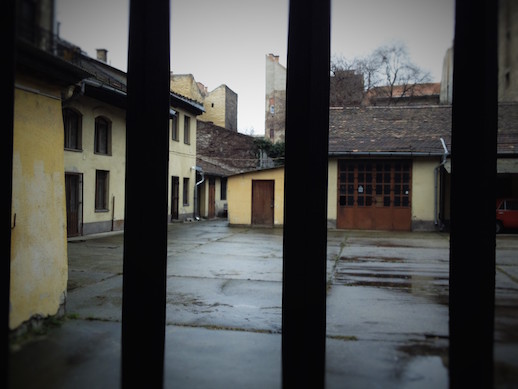 Courtyard and site of former Roma Parliament
Courtyard and site of former Roma Parliament
Further out a large wayside crucifix sits at the approach to Matyas ter, an echo of a time – not so very distant – when this was open country. The flowers that adorn it are put there by Roma, historical denizens of the roadside, and the most devout of Hungary’s Catholics.
If there is one story that is consistently absent from the plaques, squares and statuary, elided in the city’s stone records, it is that of the Roma. They would seem to stand askance from the monolithic national narrative, resistant to ‘Magyarization’ through the ages (unlike the city’s Jewry). Where once Bartok and Kodaly might have celebrated gypsy elements in Hungarian culture, now Prime Minister Orban’s supporters tire of having to deny rumours put about by the left and the even-further right concerning his own ethnicity. The Roma are absent from the feast, spectrally present at best. It is an irony that for centuries the peripatetic gypsy players kept the flame of Hungary’s folk musical traditions, a reality honoured by the great gypsy orchestras of the past. In the soviet era, many restaurants in Budapest had a house gypsy band. But the Roma alone mourn the passing of communism, days of work and affordable rent now past. So what story would the Roma tell, if anyone were listening?
Once again the reality is not simple. We spend some time with a Roma family, themselves distinguished musicians. They are Romungro, proud Hungarians first and foremost, integrated, and largely embraced by the mainstream culture (though in the present climate ‘tolerated’ might better capture it). The father of the family plays his violin for us, wonderfully well. He starts with I Could Have Danced All Night as if to emphasise the cultural continuity between us. We secretly hope for something more ‘authentic’, and yet their story is precisely one of negotiation and accommodation with the mainstream. The family we meet are, in a way, the elite players in this game. They themselves talk disparagingly of other groups, such as the Olah (Vlach), who show less guile, less inclination (or ability) to assimilate and forego their traditions. For this it seems the Olah pay a heavy price of social and economic exclusion, with all its attendant problems.
Despite the myth of gypsies as work shy, crafts and trades have always been a kind of stone soup for the Roma, their means to forging relationships of modest mutual benefit, acceptance and, to varying degrees, assimilation into the dominant cultures of Central and Eastern Europe. But having survived their own holocaust – the Pharrajimos (literally ‘fragmentation’) – you can’t but fear for the Roma again, the Olah especially, and their extended kin through Eastern Europe: despised, marginalised, scapegoated, as they are – even, alas, in Budapest where the nakedly racist Jobbik has some support. Perhaps in the febrile nationalist mind-set, the Roma are a persistent reminder of the mongrel genetics of nationhood. Perhaps the story the Roma whisper down the ages is that, like them – and like us all – the magyarok are just fellow blow-ins, another tribe from the East.
Nick Bellorini is currently writing a novel set in Budapest in the 1920s and 30s.
